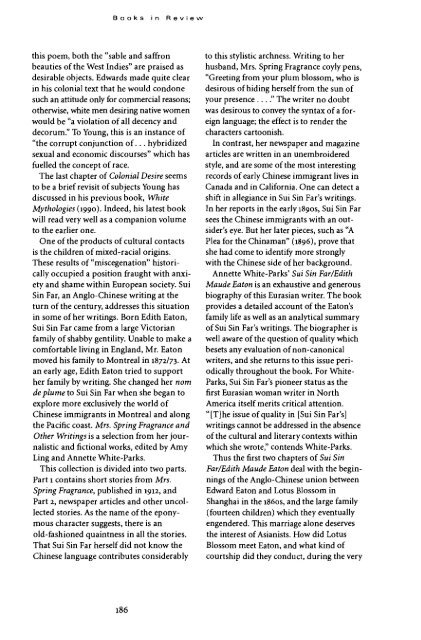A Quarterly of Criticism and Review i^^^^^^^^fcEjfc $15
A Quarterly of Criticism and Review i^^^^^^^^fcEjfc $15
A Quarterly of Criticism and Review i^^^^^^^^fcEjfc $15
You also want an ePaper? Increase the reach of your titles
YUMPU automatically turns print PDFs into web optimized ePapers that Google loves.
Books in <strong>Review</strong>this poem, both the "sable <strong>and</strong> saffronbeauties <strong>of</strong> the West Indies" are praised asdesirable objects. Edwards made quite clearin his colonial text that he would condonesuch an attitude only for commercial reasons;otherwise, white men desiring native womenwould be "a violation <strong>of</strong> all decency <strong>and</strong>decorum." To Young, this is an instance <strong>of</strong>"the corrupt conjunction <strong>of</strong>... hybridizedsexual <strong>and</strong> economic discourses" which hasfuelled the concept <strong>of</strong> race.The last chapter <strong>of</strong> Colonial Desire seemsto be a brief revisit <strong>of</strong> subjects Young hasdiscussed in his previous book, WhiteMythologies (1990). Indeed, his latest bookwill read very well as a companion volumeto the earlier one.One <strong>of</strong> the products <strong>of</strong> cultural contactsis the children <strong>of</strong> mixed-racial origins.These results <strong>of</strong> "miscegenation" historicallyoccupied a position fraught with anxiety<strong>and</strong> shame within European society. SuiSin Far, an Anglo-Chinese writing at theturn <strong>of</strong> the century, addresses this situationin some <strong>of</strong> her writings. Born Edith Eaton,Sui Sin Far came from a large Victorianfamily <strong>of</strong> shabby gentility. Unable to make acomfortable living in Engl<strong>and</strong>, Mr. Eatonmoved his family to Montreal in 1872/73. Atan early age, Edith Eaton tried to supporther family by writing. She changed her nomde plume to Sui Sin Far when she began toexplore more exclusively the world <strong>of</strong>Chinese immigrants in Montreal <strong>and</strong> alongthe Pacific coast. Mrs. Spring Fragrance <strong>and</strong>Other Writings is a selection from her journalistic<strong>and</strong> fictional works, edited by AmyLing <strong>and</strong> Annette White-Parks.This collection is divided into two parts.Part 1 contains short stories from Mrs.Spring Fragrance, published in 1912, <strong>and</strong>Part 2, newspaper articles <strong>and</strong> other uncollectedstories. As the name <strong>of</strong> the eponymouscharacter suggests, there is anold-fashioned quaintness in all the stories.That Sui Sin Far herself did not know theChinese language contributes considerablyto this stylistic archness. Writing to herhusb<strong>and</strong>, Mrs. Spring Fragrance coyly pens,"Greeting from your plum blossom, who isdesirous <strong>of</strong> hiding herself from the sun <strong>of</strong>your presence ..." The writer no doubtwas desirous to convey the syntax <strong>of</strong> a foreignlanguage; the effect is to render thecharacters cartoonish.In contrast, her newspaper <strong>and</strong> magazinearticles are written in an unembroideredstyle, <strong>and</strong> are some <strong>of</strong> the most interestingrecords <strong>of</strong> early Chinese immigrant lives inCanada <strong>and</strong> in California. One can detect ashift in allegiance in Sui Sin Far's writings.In her reports in the early 1890s, Sui Sin Farsees the Chinese immigrants with an outsider'seye. But her later pieces, such as "APlea for the Chinaman" (1896), prove thatshe had come to identify more stronglywith the Chinese side <strong>of</strong> her background.Annette White-Parks' Sui Sin Far/EdithMaude Eaton is an exhaustive <strong>and</strong> generousbiography <strong>of</strong> this Eurasian writer. The bookprovides a detailed account <strong>of</strong> the Eaton'sfamily life as well as an analytical summary<strong>of</strong> Sui Sin Far's writings. The biographer iswell aware <strong>of</strong> the question <strong>of</strong> quality whichbesets any evaluation <strong>of</strong> non-canonicalwriters, <strong>and</strong> she returns to this issue periodicallythroughout the book. For White-Parks, Sui Sin Far's pioneer status as thefirst Eurasian woman writer in NorthAmerica itself merits critical attention."[T]he issue <strong>of</strong> quality in [Sui Sin Far's]writings cannot be addressed in the absence<strong>of</strong> the cultural <strong>and</strong> literary contexts withinwhich she wrote," contends White-Parks.Thus the first two chapters <strong>of</strong> Sui SinFar/Edith Maude Eaton deal with the beginnings<strong>of</strong> the Anglo-Chinese union betweenEdward Eaton <strong>and</strong> Lotus Blossom inShanghai in the 1860s, <strong>and</strong> the large family(fourteen children) which they eventuallyengendered. This marriage alone deservesthe interest <strong>of</strong> Asianists. How did LotusBlossom meet Eaton, <strong>and</strong> what kind <strong>of</strong>courtship did they conduct, during the very186
















